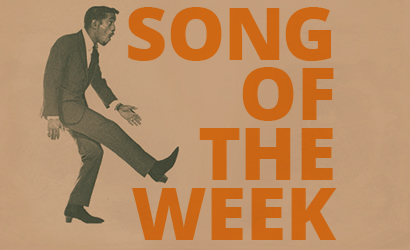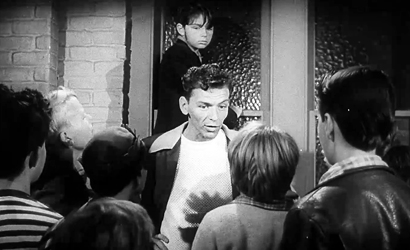One of the songs most associated with the early career of Sammy Davis, Jr.’s idol Frank Sinatra was “The House I Live In”, an inspiring (and currently topical) paean to the diversity of America. Sinatra sang the patriotic anthem throughout his career – on record, on stage, for Presidents Kennedy and Reagan, and at the centennial celebrations for the Statue of Liberty in 1986.
Sammy Davis, Jr. also recorded the song, on 20 February 1957, with an orchestra directed by Morty Stevens. The little-known recording was released only on a promotional 45. Accompanied by just a guitar for the first verse, and joined by a celesta for the second, Sammy treats it like a Broadway showstopper, with his signature big finish…
Written in 1942 for Let Freedom Sing, a Broadway revue which lasted all of 8 performances, the song first came to prominence in the 10 minute RKO short film The House I Live In, which starred Sinatra. Released in 1945, it was made to combat racial prejudice, and specifically anti-semitism, at the end of World War II. The film sees Sinatra (playing himself) lecture a gang of school kids, who are about to beat up a Jewish kid, on tolerance (image right).
The song was written by two progressive writers, the music by Earl Robinson (who was later blacklisted from Hollywood) and the lyrics by Abel Meeropol (writing under the pen name ‘Lewis Allan’). The song originally had eight verses, of which Sinatra would only ever sing four. Paul Robeson also regularly sang the song and usually included all verses. Meeropol was particularly furious when what he viewed as the most important verse was left out of Sinatra’s RKO short:
The house I live,
My neighbors white and black,
The people who just came here,
Or from generations back.
The town hall and the soapbox,
The torch of liberty,
A home for all God’s children.
That’s America to me.
Apparently that was a little too progressive for RKO in 1945!
Sammy’s version also omits this verse, and he sings the same four verses as Sinatra. Given the 1945 film short’s particular focus on anti-semitism, it’s not surprising that the 45 Sammy released in 1957 was produced by the Anti-Defamation League of B’nai Brith as a ‘public service feature’. At the time, Sammy had, of course, recently and publicly converted to Judaism.
The 45 came in a sleeve titled Sammy Davis, Jr. Singing Songs for Americans to Live By, with no reference anywhere to Decca (despite Decca being the label for which it had been recorded). The flip side of the 45 featured another song by Earl Robinson, titled “Black and White”, which tells of the 1954 Supreme Court decision which outlawed racial segregation of public schools. The reverse of the sleeve prints the full lyrics to both songs, including all eight verses of “The House I Live In”.









Hello, any chance you would be able to post the flip side of the 45, “Black And White”? Thank you so much for the video and the site and best regards.